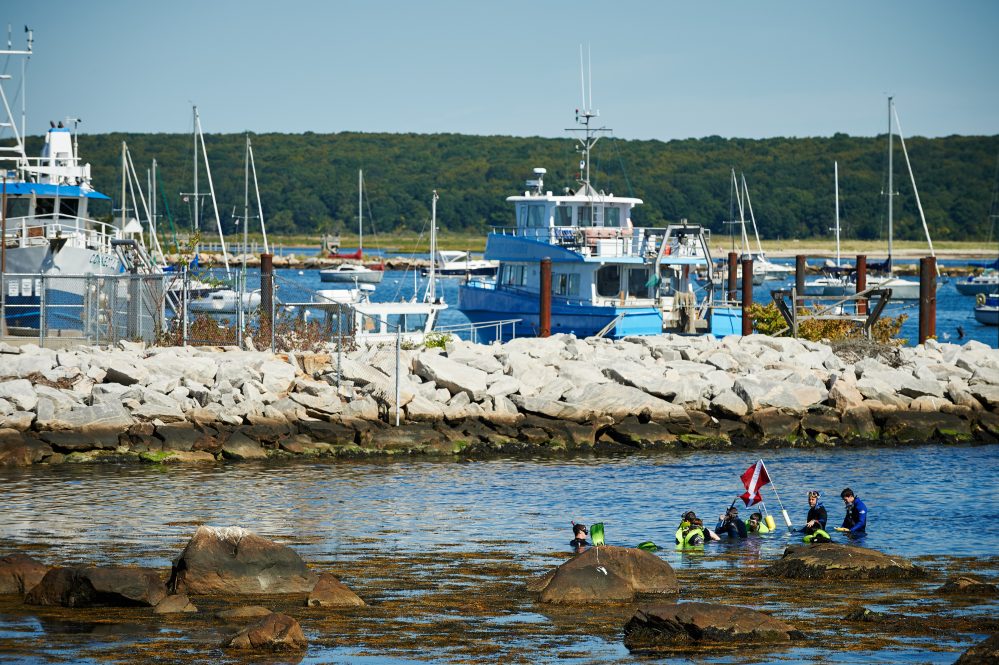When it rains around coastal communities, water that isn’t absorbed by the land often makes its way to local waters, and ultimately the ocean. This innocuous part of the water cycle becomes dangerous when the stormwater runoff picks up pollutants along the way.
When it rains, water runs off impervious surfaces. These surfaces include sidewalks, parking lots, and roads covered in hard surfaces like asphalt or concrete. These materials prevent stormwater from seeping into the ground.
Runoff water can carry pollution into local waterways. For coastal communities, stormwater runoff can pick up nitrogen from fertilizer and other sources, and transport it to the ocean, which causes a cascade of environmental consequences. An over-abundance of nitrogen in bodies like Long Island Sound can cause bacteria and algae to grow rapidly. These organisms then use up the water’s oxygen supply, making it uninhabitable for many other kinds of organisms disrupting the entire ecosystem.
Extension educator Michael Dietz and his colleagues have received a grant from the National Fish and Wildlife Foundation to implement a student-driven project to reduce runoff in at least five coastal Connecticut towns. This grant totals $272,376, including $136,254 in matching contributions from UConn. UConn’s extension program is part of the College of Agriculture, Health, and Natural Resources.
Dietz’s team will implement green stormwater infrastructure practices for these communities. Dietz previously investigated this approach in a project with Rutgers University. Dietz will now adapt that approach for the coastal Connecticut watershed.
For me, this multi-disciplinary project is unique because it has a such wide range of tangible benefits — Michael Dietz
This project will provide hands-on learning for graduate and undergraduate students.
The faculty on this multi-disciplinary project include extension educators Chester Arnold and David Dickson; assistant professor of plant science and landscape architecture Sohyun Park; and associate professor and director of the Environmental Engineering Program in the Department of Civil and Environmental Engineering Timothy Vadas.
“For me, this multi-disciplinary project is unique because it has a such wide range of tangible benefits,” Dietz says.
Undergraduate students will learn how to perform detailed stormwater assessments and present them to stakeholders professionally. The graduate student on this project will gain experience managing and providing guidance for the undergraduate students.
This team will teach students how to use information such as geospatial data and field inspections to construct rapid assessment plans (RAPs). The RAPs will include multiple recommendations about how municipalities can retrofit their existing infrastructure to reduce stormwater runoff and nitrogen pollution.
Students will complete these assessments for each municipality in the study. They will then present their findings to municipal staff in each town, who will determine which practice will work best for their community. The UConn investigators will coordinate the installation of the selected practice, resulting in tangible water quality improvements.
“The municipalities are very appreciative of having these assessments done, as it helps them to determine where to focus their efforts to most efficiently reduce stormwater pollution,” Dietz says. “This project will also result in the actual installation of multiple green stormwater features in these communities, reducing stormwater pollution.”
This project will also benefit local schools as many of the installations will be at schools. Local science teachers can use them as teaching tools to incorporate into their curricula.
Once implemented, these installations have the potential to disconnect 20,000 square feet of impervious cover from local waterways and reduce runoff by 500,000 gallons. It will also reduce nitrogen export to Long Island Sound by an estimated five pounds annually.
Another important aspect of this project involves helping the towns improve their land use regulations in ways that will pave the way for future green stormwater infrastructure installations.
Dietz holds a Ph.D. in water resources from UConn, and is a joint faculty member in the department of Natural Resources and the Environment. He directs the Connecticut Institute of Water Resources, (CT IWR), and co-directs the Connecticut Nonpoint Education for Municipal Officials (NEMO) program with David Dickson, in the Center for Land Use Education and Research (CLEAR). His work focuses on protecting surface waters with an emphasis on green infrastructure techniques.



